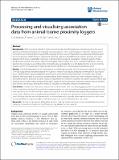Processing and visualising association data from animal-borne proximity loggers
Abstract
Background With increasing interest in animal social networks, field biologists have started exploring the use of advanced tracking technologies for mapping social encounters in free-ranging subjects. Proximity logging, which involves the use of animal-borne tags with the capacity for two-way communication, has attracted particular attention in recent years. While the basic rationale of proximity logging is straightforward, systems generate very large datasets which pose considerable challenges in terms of processing and visualisation. Technical aspects of data handling are crucial for the success of proximity-logging studies, yet are only rarely reported in full detail. Here, we describe the procedures we employed for mining the data generated by a recent deployment of a novel proximity-logging system, “Encounternet”, to study social-network dynamics in tool-using New Caledonian crows. Results Our field deployment of an Encounternet system produced some 240,000 encounter logs for 33 crows over a 19-day study period. Using this dataset, we illustrate a range of procedures, including: examination of tag reciprocity (i.e. whether both tags participating in an encounter detected the encounter and, if so, whether their records differed); filtering of data according to a predetermined signal-strength criterion (to enable analyses that focus on encounters within a particular distance range); amalgamation of temporally clustered encounter logs (to remove data artefacts and to enable robust analysis of biological patterns); and visualisation of dynamic network data as timeline plots (which can be used, among other things, to visualise the simulated diffusion of information). Conclusions Researchers wishing to study animal social networks with proximity-logging systems should be aware of the complexities involved. Successful data analysis requires not only a sound understanding of hardware and software operation, but also bioinformatics expertise. Our paper aims to facilitate future projects by explaining in detail some of the subtleties that are easily overlooked in first-pass analyses, but are key for reaching valid biological conclusions. We hope that this work will prove useful to other researchers, especially when read in conjunction with three recently published companion papers that report aspects of system calibration and key results.
Citation
Bettaney , E , James , R , St Clair , J & Rutz , C 2015 , ' Processing and visualising association data from animal-borne proximity loggers ' , Animal Biotelemetry , vol. 3 , 27 . https://doi.org/10.1186/s40317-015-0065-4
Publication
Animal Biotelemetry
Status
Peer reviewed
ISSN
2050-3385Type
Journal article
Description
The authors thank the BBSRC (Grants BB/G023913/1 and/2 to CR) and the University of Bath (studentship to EMB) for funding.Collections
Items in the St Andrews Research Repository are protected by copyright, with all rights reserved, unless otherwise indicated.

